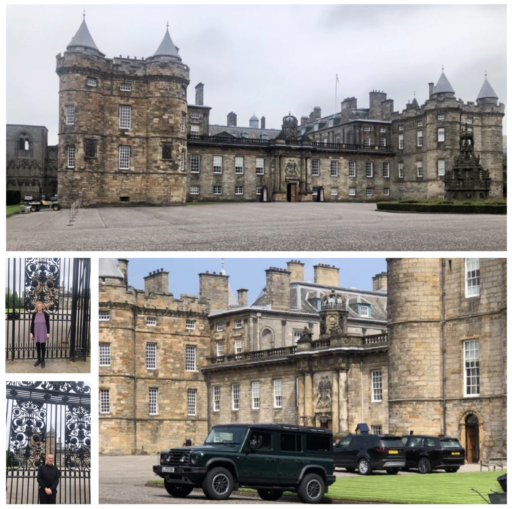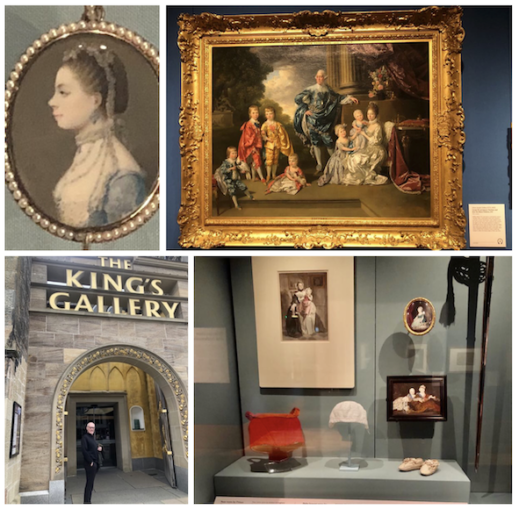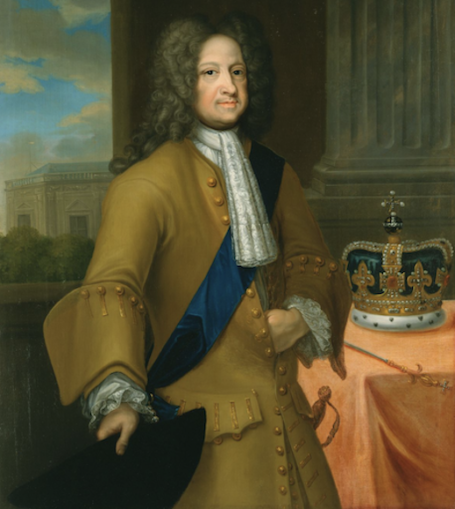On our day trip to Edinburgh, Mrs AWS and I de-trained on Waverley’s Platform 9 at 12:17 prompt. While a disappointing first-class breakfast rattled in our tums, we allowed ourselves to be swept out of the Market Street exit on the southern side of the station. Ordinarily Princess Street kind of people, we found ourselves staring at the Brewhemia hostelry’s colourfully bedecked floral frontage.
Was that a rainbow flag? ‘We’re leaving,’ I whispered to my wife. We hurried down hilly Market Street and into nondescript West Market Street with its modern, bland council offices, tax offices and other municipal buildings. As for the style of the architecture, am I allowed to call this the Premier Inn Quarter?
However, at a mini-roundabout, beside what looked like a caravan park’s pub, shop, lavatory and pool complex, we found ourselves happening upon the Royal Palace of Holyroodhouse.
The Palace of Holyroodhouse
The story of the Palace of Holyroodhouse, also known simply as Holyrood Palace and located at the end of Edinburgh’s Royal Mile, begins almost a millennium ago in 1128 AD. It was then that King David I of Scotland founded the Augustinian Holyrood Abbey. The abbey was established following a vision of a holy cross (or rood) that reportedly saved the king from a charging stag. This divine intervention inspired the abbey’s name, “Holyrood,” meaning “Holy Cross.”
The transformation of Holyrood Abbey into a royal residence began in the late 15th century. Around 1501, James IV of Scotland constructed a guesthouse at the abbey, laying the groundwork for the future palace.
By the mid-16th century, Holyroodhouse had become an established royal residence. It was significantly expanded under the reign of James V, who added a tower in the 1520s. This structure, known as the James V Tower, remains a prominent feature of the palace and can be seen to the top left of the photograph below. Close up, the two black oblongs at first-floor level show the ornamental arms of Mary of Guise and James V.

© Always Worth Saying 2024, Going Postal
One of the palace’s most famous residents was Mary, Queen of Scots. Mary moved into the palace in 1561, and it became the backdrop for some of the most dramatic events of her reign. The most notable incident occurred in 1566, when her secretary and confidant, David Rizzio, was brutally murdered in her private apartments by a group of nobles led by her jealous husband, Lord Darnley.
A fellow traveller, Mary also journeyed between Edinburgh and my Debatable Lands home where she was kept prisoner in our local castle. Moaning all the time (typical Scot), the garrison had a novel idea to keep her occupied. After blowing up a pig’s bladder, they divided into two teams and kicked it about the parade ground while the Queen watched from behind her bars.
Thus, despite what Likeaker, Wokegate and the history books might tell you, the game of Association Football (Maryball?) was invented in Carlisle. To this day, it is still practised there at Brunton Park, fittingly also a place of solitude, sorrow and loud moans.
Later, when Mary was transferred to Northamptonshire, she continued to complain. With tragic consequences to herself, she went on and on and on about the bed being too short and the ceiling too low. Ouch!
Holyroodhouse Palace continued to evolve throughout the 17th century. King James VI of Scotland (who also became James I of England) made improvements, and the palace played host to several royal events.
However, the palace also endured periods of strife. During the mid-17th century, Holyroodhouse suffered damage in the English Civil War. Following the Restoration of the monarchy, Charles II ordered the rebuilding of the palace in the 1670s. A prominent Scottish architect, Sir William Bruce, oversaw the reconstruction, adding Baroque elements that defined much of the palace’s current appearance.
The 18th century saw a decline in the use of Holyroodhouse as a royal residence. It fell into disrepair, and parts of the abbey were destroyed during a storm in 1768. The palace was occasionally used for state functions and served as a residence for royal family members during visits to Scotland.
A revival occurred in the 19th century when King George IV visited Edinburgh in 1822. This visit sparked renewed interest in Scottish culture and heritage, leading to restoration efforts. Queen Victoria further solidified Holyroodhouse’s status as a royal residence by making several visits and ordering refurbishments.
In the 20th century, Holyroodhouse continued to serve as the British monarch’s official residence in Scotland. Queen Elizabeth II frequently used the palace for state functions and ceremonies, particularly during her annual “Royal Week” in Scotland.
Five and a half centuries after the Queen of Scot’s incarceration, the coffin of Mary’s 11 times great-granddaughter, Elizabeth II, was laid overnight at Holyrood after travelling by hearse from Balmoral. The following day, thousands watched in silence as Her Majesty’s coffin made its journey halfway along the Royal Mile to lie in state at St Giles Cathedral. I’m sure I’m not the only Puffin who thought that throughout the sombre proceedings, the Scots excelled themselves.
Hanoverians in the Kings Gallery
Did someone mention King George? Above the arched gateway beside the west entrance to the palace, I and Mrs AWS spotted a giant sign proclaiming the King’s Gallery. Being crushing snobs, the pair of us couldn’t resist.
For a reasonable tenner each, a gentleman from the provinces and his lady companion may enjoy paintings and antiques from the royal collection, plus special exhibitions, in a royal building.

© Always Worth Saying 2024, Going Postal
Only a tenner? Well, yes, but there’s more. The girl on the till, incidentally the only Scottish accent we heard all day, had the temerity to ask if we could gift aid the entrance fee so Aston Martin driving, wind farm trillionaire King Charles could claim the tax back. No thanks.
And anyway, your humble author isn’t a big fan of paying taxes. Despite my self-assessment accounts varying from being works of art to being works of genius, this year I have been caught out. As a result, the Crown will be getting a slice of my sweat whether I gift aid my gallery tickets or not.
Bigly financially triggered, the poor chap who checks bags and pockets for tins of Just Stop Oil vivid orange had to listen to me tell him to buy the shares if he was concerned about water company dividends. Plus, if he thought Mrs Truss had wrecked the economy, he obviously wasn’t one of the far-sighted souls benefitting from their investment in her high-yielding bonds.
By the time I’d climbed the stairs to the gallery, I had both calmed down and passed a sign informing us that the present theme of the royal collection hangings was the fashions of the Hanoverian 18th century.
The Worth-Sayings did rather well out of the Kings George. Four Hanoverian Georges reigned in succession from 1714-1830, by which time the Worth-Sayings were respectable north country farmers with a decent acreage. By the 1851 census, the first in which a farmer declared his land, my direct ancestor was husbanding a respectable 155 acres.
The American side of the family benefited both before and after King George III gave away the Colonies. They were prosperous Maryland plantation owners, generously providing unpaid employment to architects and brain surgeons who had recently arrived in boats from West Africa.
Although the exhibition showed that fashions of the time could be a bit extravagant, I would like to think my forebears dressed like this chap, only one or two narrow social strata above the farming Worth-Sayings: King George I.

1720s portrait of George by Georg Wilhelm Lafontaine,
Royal Collection – Licence CC BY-SA 2.0
People who know about such things inform me that Lafontaine’s portrait presents a detailed and dignified representation of the monarch. The painting captures the king’s regal bearing, adorned in luxurious royal attire, emphasising his authority and stature. I beg to disagree.
Even this philistine can recognise the blue sash of the Order Of The Garter and the St Edward’s Crown made for Charles II in 1661 and still worn by King Charles III to this day. But I can also see the simple cut and plain colours of the tunic, with the only flourishes being about the neck and cuffs.
Likewise, the background. Not exactly Arcadia, is that the tradesman’s entrance at Buckingham Palace? I think it could be. Might King George have been a reluctant king, even to the point of being one of us?
George I inherited the throne after the death of his second cousin, Queen Anne, in 1714. Over fifty individuals had a stronger claim to the throne, but they were all Catholics, and the Act of Settlement of 1701 decreed that the monarch should be a Protestant.
The future king was born in Hanover, Germany, in 1660 as George Ludwig of Brunswick-Lünebur. Coming to the throne aged 54, the new king had little knowledge of the politics or language of his new realm.
He favoured simplicity and practicality in dress rather than the ostentatious formality of court. During his regular trips back to Hanover, George left the governance of Britain in the hands of his ministers, notably Robert Walpole, often viewed today as the first Prime Minister.
For over half a century, the Jacobite movement tried unsuccessfully to have the Georgian monarchs deposed and replaced with those they regarded as their rightful kings. The best-known rebellion during George I’s reign was the Jacobite rising of 1715. This was an unsuccessful attempt begun in Scotland to gain the throne for Anne’s Catholic half-brother, James Francis Edward Stuart, known as the Old Pretender.
Another fellow traveller, Bonnie Prince Charlie captured Carlisle while heading south and passed through again in haste, heading north after a defeat at Derby. Pursued by William Duke of Cumberland’s, known south of the border as Sweet William and north of it as Bloody Billy.
Back outside the gallery, our eyes were drawn to the caravan park complex opposite. Unusually for a shop, bar, swimming pool and public lavatory, the mishmash of concrete beneath a higgledy-piggledy roof appeared to have an expel-the-Jews peace camp attached. One felt obliged to investigate!
To be continued…
© Always Worth Saying 2024



